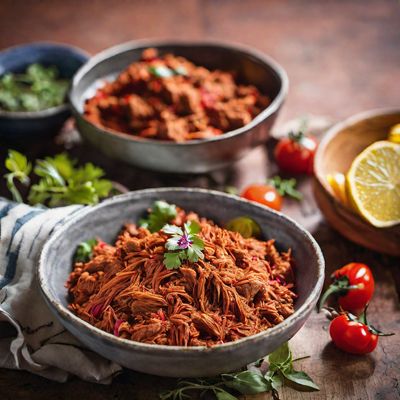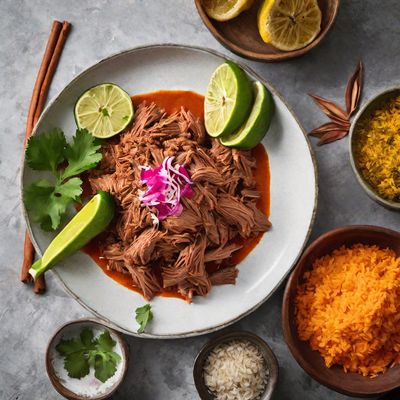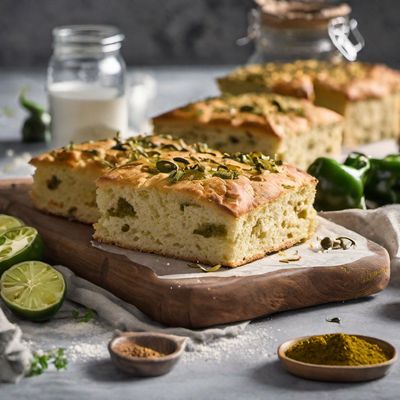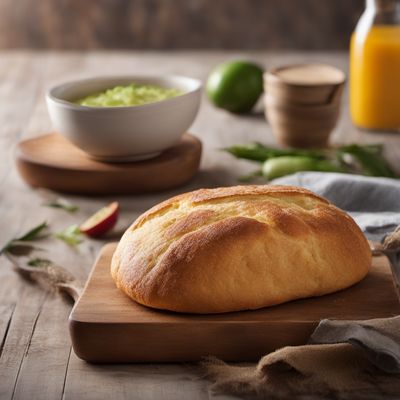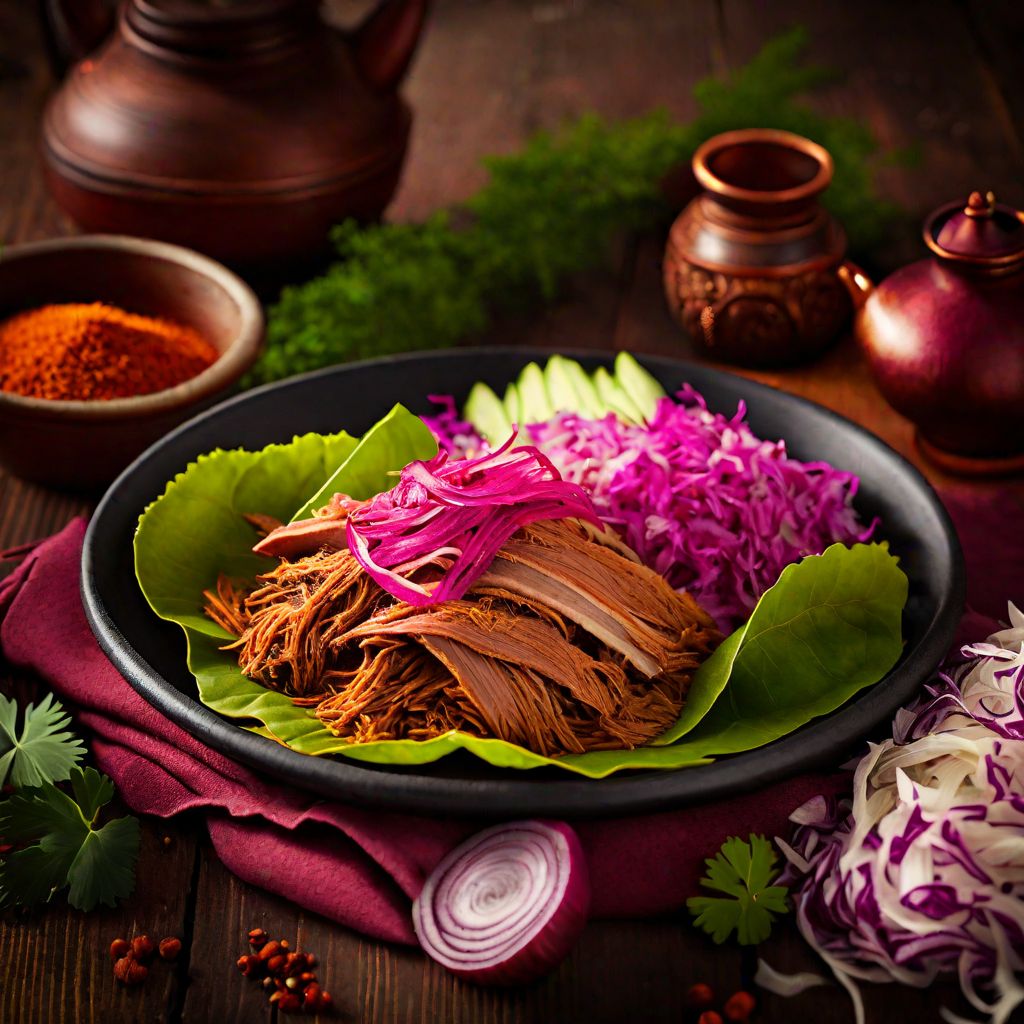
Recipe
Cochinita Pibil - Latvian Style
Smoky and Tender Latvian-Style Pulled Pork
4.7 out of 5
In the heart of Latvian cuisine, we have adapted the traditional Mexican dish, Cochinita Pibil, to create a unique and flavorful experience. Our Latvian-style Cochinita Pibil combines the rich and smoky flavors of slow-cooked pulled pork with a touch of local spices and ingredients. Get ready to indulge in a mouthwatering dish that will transport you to the vibrant streets of Riga.
Metadata
Preparation time
20 minutes
Cooking time
4-5 hours
Total time
4 hours and 25 minutes
Yields
4-6 servings
Preparation difficulty
Medium
Suitable for
Omnivore, Gluten-free, Dairy-free, Nut-free, Low-carb
Allergens
N/A
Not suitable for
Vegan, Vegetarian, Paleo, Keto, Halal
Ingredients
While the original Mexican Cochinita Pibil is traditionally cooked in banana leaves and marinated with achiote paste, our Latvian adaptation incorporates local flavors and ingredients. We substitute the banana leaves with cabbage leaves, which add a subtle earthy taste to the dish. Additionally, we use a blend of Latvian spices and herbs to enhance the flavors of the slow-cooked pork. We alse have the original recipe for Cochinita pibil, so you can check it out.
-
2 kg (4.4 lbs) pork shoulder, bone-in 2 kg (4.4 lbs) pork shoulder, bone-in
-
4 large cabbage leaves 4 large cabbage leaves
-
4 tablespoons vegetable oil 4 tablespoons vegetable oil
-
2 onions, thinly sliced 2 onions, thinly sliced
-
4 garlic cloves, minced 4 garlic cloves, minced
-
2 tablespoons paprika 2 tablespoons paprika
-
1 tablespoon caraway seeds 1 tablespoon caraway seeds
-
1 tablespoon dried thyme 1 tablespoon dried thyme
-
1 tablespoon dried marjoram 1 tablespoon dried marjoram
-
1 tablespoon salt 1 tablespoon salt
-
1 tablespoon black pepper 1 tablespoon black pepper
-
1 tablespoon brown sugar 1 tablespoon brown sugar
-
1 cup (240 ml) apple cider vinegar 1 cup (240 ml) apple cider vinegar
-
1 cup (240 ml) water 1 cup (240 ml) water
Nutrition
- Calories (kcal / KJ): 400 kcal / 1674 KJ
- Fat: 20g (Saturated Fat: 6g)
- Carbohydrates: 10g (Sugars: 4g)
- Protein: 45g
- Fiber: 2g
- Salt: 1.5g
Preparation
-
1.Preheat the oven to 160°C (320°F).
-
2.In a large Dutch oven or oven-safe pot, heat the vegetable oil over medium heat.
-
3.Add the sliced onions and minced garlic to the pot and sauté until they become translucent.
-
4.In a small bowl, combine the paprika, caraway seeds, dried thyme, dried marjoram, salt, black pepper, and brown sugar to create a spice rub.
-
5.Rub the spice mixture all over the pork shoulder, ensuring it is evenly coated.
-
6.Place the cabbage leaves at the bottom of the pot, creating a bed for the pork.
-
7.Place the seasoned pork shoulder on top of the cabbage leaves.
-
8.Pour the apple cider vinegar and water into the pot, ensuring the liquid reaches about halfway up the pork shoulder.
-
9.Cover the pot with a lid and transfer it to the preheated oven.
-
10.Slow-cook the pork for approximately 4-5 hours, or until it becomes tender and easily shreds with a fork.
-
11.Once cooked, remove the pork from the pot and shred it using two forks.
-
12.Return the shredded pork to the pot and mix it with the cooking juices.
-
13.Serve the Latvian-style Cochinita Pibil on warm bread rolls or alongside traditional Latvian side dishes.
Treat your ingredients with care...
- Pork shoulder — Choose a well-marbled cut of pork shoulder for maximum flavor and tenderness.
- Cabbage leaves — Select fresh and large cabbage leaves to create a flavorful bed for the pork.
- Apple cider vinegar — Opt for high-quality apple cider vinegar to enhance the tangy flavor of the dish.
- Latvian spices — Use authentic Latvian spices for an authentic taste. If unavailable, you can substitute with a blend of caraway seeds, thyme, and marjoram.
Tips & Tricks
- For a smokier flavor, you can add a small amount of liquid smoke to the spice rub.
- If you prefer a spicier dish, add a pinch of cayenne pepper to the spice rub.
- Serve the Latvian-style Cochinita Pibil with a dollop of sour cream or yogurt for added creaminess.
- Leftover pulled pork can be used in sandwiches, tacos, or salads for a delicious meal the next day.
- To save time, you can prepare the spice rub and marinate the pork overnight for even more flavor.
Serving advice
Serve the Latvian-style Cochinita Pibil on warm bread rolls, accompanied by a side of pickled vegetables and a fresh green salad. The tender and smoky pulled pork pairs perfectly with the tangy and crunchy pickles, creating a delightful combination of flavors and textures.
Presentation advice
Garnish the Latvian-style Cochinita Pibil with a sprinkle of fresh herbs, such as parsley or dill, to add a pop of color to the dish. Serve it in a rustic-style serving dish or on a wooden platter to enhance the homemade and comforting feel of the meal.
More recipes...
For Cochinita pibil » Browse all
For Mexican cuisine » Browse all
More Mexican cuisine dishes » Browse all

Mogolla
Mogolla is a traditional Mexican bread that is similar to a baguette. It has a crispy exterior and a soft, chewy interior.

Pitilla
Pitilla is a traditional bread from the Mexican state of Oaxaca. It is a flatbread that is typically made with cornmeal and is often served with...

Tacos de cabeza
Cabeza Tacos
Tacos de cabeza are a traditional Mexican dish that feature slow-cooked beef head meat and a variety of flavorful toppings. These tacos are...
More Latvian cuisine dishes » Browse all

Purtumute
Green Bean Stew
Purtumute is a traditional dish from the island of Sardinia in Italy.

Resi
Resi is a Sri Lankan dish made with rice and coconut milk. It is a creamy and flavorful dish that is often served at special occasions.

Kliņģeris
Kliņģeris is a traditional Latvian pastry that is made with a sweet yeast dough and filled with a variety of fillings such as jam, nuts, or poppy...

